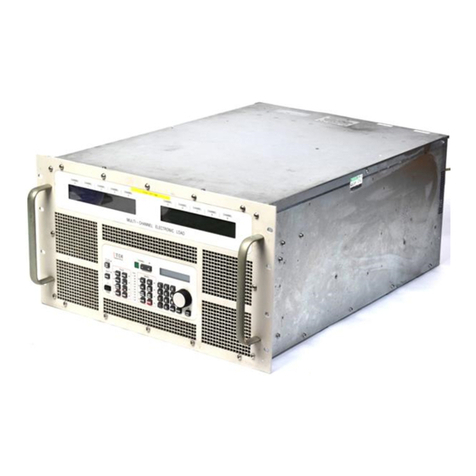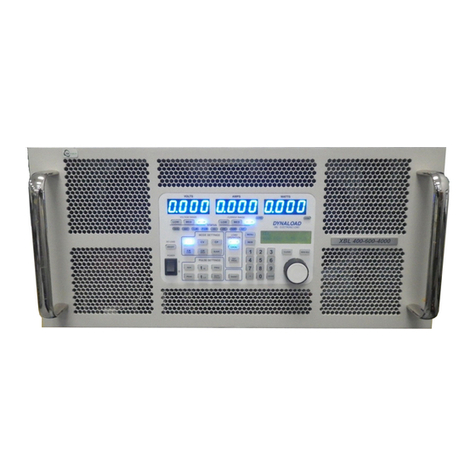TDI TDI-Dynaload WCL488 Series Owner's manual

WCL488 Series
Water Cooled
Electronic Loads
Operation & Programming Manual
TDI-Dynaload®Division
Document Number 402828 — Revision B1

© 2003 TDI-Dynaload — All Rights Reserved.
The copyright laws of the United States and other countries protect this material. It may not be
reproduced, distributed, or altered in any fashion without the expressed written consent of TDI-
Transistor Devices, Inc.
Disclaimer
The contents of this document, including all specifications, are subject to change without notice.
Mandatory Customer Information
Federal Communications Commission (FCC) Statement
NOTE: This equipment has been tested and found to comply with the limits for a Class A digital
device, pursuant to Part 15 of the FCC Rules. These limits are designed to provide reasonable
protection against harmful interference when equipment is operated in a commercial
environment. This equipment generates, uses, and can radiate radio frequency energy; and, if not
installed and used in accordance with the instruction manual, may cause interference to radio
communications. Operation of this equipment in a residential area may cause harmful interference
in which case the user will be required to correct the interference at their expense.
Trademarks
Dynaload is a registered trademark of Transistor Devices, Inc.
Ordering Information
The ordering number for this document is 402828. To order this document, contact:
TDI-Dynaload Division
36A Newburgh Road
Hackettstown, NJ 07840
Telephone: (908) 850-5088
Facsimile: (908) 850-0679
Online Availability
To find out more about TDI and our products, visit us on the web at: http://www.tdipower.com/ or
visit TDI-Dynaload directly at: http://www.tdipower.com/dynaload/.
Customer Services
For technical assistance regarding our products, contact the following:
Sales Inquires
Dynaload Sales Manager
Telephone: (908) 850-5088
Facsimile: (908) 850-0679
Customer Service and Repairs
Dynaload Customer Service Department
Telephone: (908) 850-5088
Facsimile: (908) 850-3645

TDI-Dynaload Division WCL488 Series Water Cooled Electronic Loads
Operation & Programming Manual
402828, Rev. B1 Page i
Contents
Chapter 1 — Overview................................................................................... 1
Introduction............................................................................................................1
Modes of Operation ...............................................................................................2
Constant Current Mode .............................................................................................2
Constant Resistance Mode.........................................................................................3
Constant Voltage Mode.............................................................................................3
Constant Power Mode ...............................................................................................4
Pulse Mode ................................................................................................................4
Full Scale Range Switching.......................................................................................4
WCL488 Front Panel Features and Controls .....................................................5
Chapter 2 — Installation and Wiring.............................................................. 7
Operator Safety Instructions and Symbols .........................................................7
Cooling Connections and Requirements..............................................................8
Thermal Transfer Characteristics...............................................................................8
Special Information for Ethylene Glycol Users.......................................................11
WCL488 Typical Rear Panel Connections........................................................12
WCL488 Rear Panel Electrical Connections ....................................................13
WCL488 E+ and E– Power Input Buses .................................................................13
WCL488 E+ and E–Wiring Tips.......................................................................13
WCL488 The “IEEE-488” Connector (RS232 Optional) .......................................14
WCL488 AC Input ..................................................................................................14
WCL488 Input Voltage Selector .............................................................................14
WCL488 Fuse Replacement....................................................................................14
WCL488 AC Input Wiring Tips.........................................................................15
WCL488 Slave Communication Connector ............................................................15
WCL488 Slave Communication Connector Wiring...........................................15
WCL488 UV (Undervoltage Lockout) Switch........................................................15
WCL488 Relay Connector ......................................................................................16
WCL488 Chassis Ground Connection ....................................................................16
The WCL488 Terminal Block and Terminal Block Connections ...........................17

WCL488 Series Water Cooled Electronic Loads
Operation & Programming Manual
TDI-Dynaload Division
Page ii 402828, Rev. B1
CS (Current Sample)...........................................................................................17
REM (Remote or External Programming)..........................................................18
SYN (Synchronized Output Signal) ...................................................................18
EN (Remote Enable)...........................................................................................18
S– and S+ (Voltage Sense) .................................................................................18
S– and S+ (Voltage Sense) Wiring Tips ......................................................18
E– and E+ (Input) ...............................................................................................19
WCL488 Terminal Block Connections Optional Equipment Wiring.................20
Recommended Operating Procedure.................................................................21
Operating Mode Guidelines................................................................................22
CI — Constant Current Mode (Basic Mode)...........................................................22
CR — Constant Resistance Mode (Basic Mode).....................................................22
CV — Constant Voltage Mode (Basic Mode).........................................................23
CP — Constant Power Mode (Basic Mode)............................................................23
Short Circuit ............................................................................................................23
MEM — Memory Recall Locations........................................................................23
Manual Adjust .........................................................................................................23
Remote Programming..............................................................................................23
Local Control...........................................................................................................24
Fault Indicators........................................................................................................24
Undervoltage Lockout.............................................................................................25
Programmable Under Voltage.................................................................................25
Menu Commands.....................................................................................................26
Current Limit Setting..........................................................................................27
Range Switching and Current Limit Set Point....................................................27
Voltage Limit Setting .........................................................................................27
Power Limit Setting............................................................................................27
Slew Rate Adjustment ........................................................................................27
Encoder Resolution Setting ................................................................................27
Front Panel Configuration Memory Set .............................................................28
Front Panel Lock ................................................................................................28

TDI-Dynaload Division WCL488 Series Water Cooled Electronic Loads
Operation & Programming Manual
402828, Rev. B1 Page iii
IEEE Address Setting .........................................................................................28
Password Change................................................................................................28
SF/SS (Slew Range) ...........................................................................................28
Number Of Pulses...............................................................................................28
Terminator (CR/CR-LF).....................................................................................28
LCD Contrast Adjust..........................................................................................29
Select Amps/Volt Or Ohms................................................................................29
Check Firmware Revision ..................................................................................29
Programmable UV Level....................................................................................29
Pulse Mode ..............................................................................................................29
Manual Operation...............................................................................................29
IEEE-488 Programming .....................................................................................30
Effects of Cable Inductance On Pulse Loading.......................................................31
Effects Of Cable Length......................................................................................32
Current Oscillation ..................................................................................................32
Line Loss .................................................................................................................32
Transconductance....................................................................................................34
Location, Airflow, Maintenance..............................................................................34
WCL488/WCS Water Cooled Load Systems ....................................................35
Synchronized Paralleling.........................................................................................35
Slave Configuration.................................................................................................36
Water Cooled Load Systems Components and Wiring ...........................................37
WCS Front Panel Features and Controls..........................................................39
WCS Rear Panel Electrical Connections...........................................................40
WCS E+ and E– Power Input Buses .......................................................................40
WCS E+ and E–Wiring Tips .............................................................................40
WCS AC Input ........................................................................................................41
WCS Input Voltage Selector ...................................................................................41
WCS AC Input Wiring Tips ...............................................................................41
WCS Fuse Replacement ..........................................................................................42
WCS Slave Communication Connector ..................................................................42
WCS Slave Communication Connector Wiring .................................................42
This manual suits for next models
3
Table of contents
Other TDI Industrial Equipment manuals




















